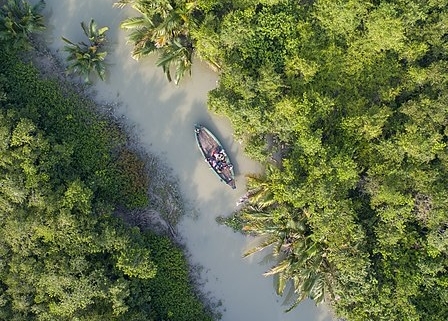Check out Everything about Sundarban Mangrove Forest
Sundarbans National park is a part of the UNESCO World Heritage Site and grants sanctuary to around 100 alluring Royal Bengal Tigers, which are still believed to hunt humans for food. Although these rare breeds of strong swimmers are out of sight and remain hidden in the tiger reserves, solo travel still entails signing up for a travel guide.
“Sundarban” is a Bengali word meaning “beautiful forest.” It is the most extensive tangle of mangrove trees at the mouth of the Ganges, Meghna, and Brahmaputra Rivers in the Bay of Bengal. The magnificent Sundarban Mangrove forest spans up to 10,000 square kilometers (3,900 sq. miles), of which 35% lies in West Bengal, India, and the rest in Khulna, Bangladesh. An archipelago of 102 islands prevails in the Indian segment of Sundarbans, of which only 54 are inhabited.
History:
The remains of Chand Sadagar in Baghmara Forest Block, the ruins at Netidhopani, the Sundarbans village drawings by Frederic P. Layard, and other historical ramshackle in the Sundarbans give an idea of the history of this delta. If you plan to travel solo, these spots are significant tourist attractions.
In the Mughal period, sometime around 200-300 AD, the emperors leased the lands to the residents of Sundarbans. Akbar’s army also warded off criminals in the forests, where tigers later attacked these refugees. Mughals lost most buildings to the hands of salt smugglers and Portuguese pirates in the 16th and 17th centuries.
Why should we opt for Sunderbans?
The tranquil Sundarbans, a network of coastal mangrove plants, mark the border between India and Bangladesh. In addition, a wide range of animal and plant types call them home. What distinguishes these forests from others, then?
The thrilling potential to see a Royal Bengal Tiger in addition to other unique species like water monitors, king cobras, or rock pythons.
If you love animals, go to the Sundarbans. Bird watching is your go-to pastime to pass the time when exploring these swampy areas alone.
More than sixty plant species, including the yellow Khalsi and crimson Kankra flowers, are aesthetically pleasing.
Walk through the magical settlements throughout the Sundarban Mangrove forest to learn about the residents’ way of life. If you ask nicely enough, the neighborhood beekeepers will also give you samples of freshly harvested honey to taste.
Any journey, whether taken in a group or alone, should have as its main objective safely observing and photographing the local wildlife, which is possible through watchtower sightings. Famous watchtowers with panoramic views of wildlife, including birds, deer, and tigers, can be located deep within the forest, including Sajnekhali, Sudhanyakhali, Dobanki, and Burir Dabri.
If you are sick of living at the same old hotels or resorts, why not try boat housing this time? Onboard one of the floating vessels and enjoy traditional Sundarbans cuisine while experiencing life in the clouds.
What are the things that you can buy from Sundazrbans?
The locals gather natural honey taken from the jaw of the Royal Bengal Tiger in April and May. You can buy some for yourself and your family to appreciate or try it first.
When you return from a solo journey, consider buying some lovely handicrafts from the locals to bring home as souvenirs or to give as presents to family and friends back home.
Another well-known product of Sundarbans is sustainable brown rice, which is delicious and excellent for your health.
What do Sundarbans hold for you?

Ecoregions of the “Sundarbans freshwater swamp woodlands” and “Sundarbans mangroves” can be located here. This is one of the three biggest mangrove forests in the world. There are numerous trees, diverse animals and fish, and, most importantly, a romantic and ethereal atmosphere. The variety with the most individuals is the Sundri tree.
The main attraction here is the Royal Bengal Tiger
This forest is home to the Royal Bengal Tiger, also known as Panthera tigris tigris, and other small cats like the Jungle cat, Fishing cat, and Leopard cat. Unbelievably, lions are known to live here and even swim in the water. Their most frequent victims are deer, wild pigs, and monkeys. There are thought to be 180 tigers in this region. Additionally, there are 20,000–30,000 spotted deer. There are a lot of people who live near and in the woodland. They eat items found in the forest, including fish, honey, and different kinds of wood, among other things. When humans and animals coexist in such proximity, conflict is inevitable. This leads to the death of about 30 to 100 people each year.
How to reach the Sundarbans?
This jungle has entry spots for curious visitors in Bangladesh and India.
On the Indian side, Calcutta is the launching place for boat excursions into the jungle (Kolkata). The National Park and the metropolis of Calcutta are separated by about 100 kilometers (very well-connected by air, train, and road). You could get to Canning by car or rail and proceed to Godkhali Jetty. You’ll need to rent a boat to travel from here to the Sundarbans.
You could fly to Jessore in Bangladesh and then travel to Khulna at the Sundarbans entrance. As an alternative, you could also take the train or transport to get from Dhaka to Khulna. Spending the night in the Sundarbans and taking a boat through the jungle is the best way to experience it.
What time of year is ideal for exploring the Sundarbans?
Due to the pleasant weather and higher likelihood of seeing untamed animals, November through March are perfect. The hottest and most uncomfortable weather of the year is usually experienced from April through June. Monsoons occur in the other months of the year, rendering them unfavorable travel months.





